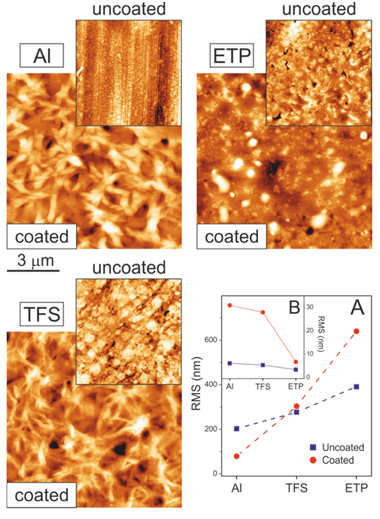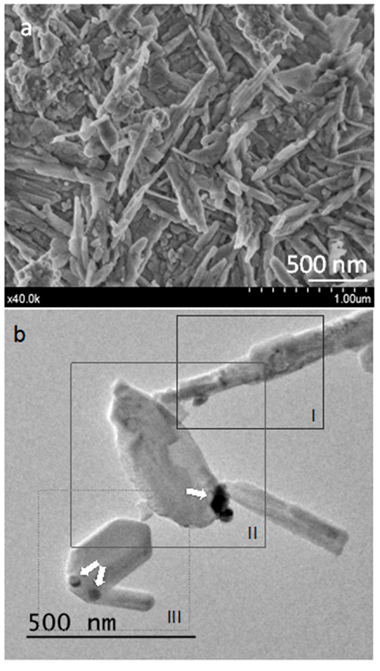Scientific Papers in SCI
2020
2020
Nanotecnología en Superficies y Plasma
Advanced Strategies in Thin Films Engineering by Magnetron Sputtering
Palmero, A; Martin, NCoatings, 10 (2020) 419
Show abstract ▽
This Special Issue contains a series of reviews and papers representing some recent results and some exciting perspectives focused on advanced strategies in thin films growth, thin films engineering by magnetron sputtering and related techniques. Innovative fundamental and applied research studies are then reported, emphasizing correlations between structuration process parameters, new ideas and approaches for thin films engineering and resulting properties of as-deposited coatings.
April, 2020 | DOI: 10.3390/coatings10040419
Materiales de Diseño para la Energía y Medioambiente
Bio-Based Coatings for Food Metal Packaging Inspired in Biopolyester Plant Cutin
Benitez, JJ; Osbild, S; Guzman-Puyol, S; Heredia, A; Heredia-Guerrero, JAPolymers, 12 (2020) 942
Show abstract ▽

Metals used for food canning such as aluminum (Al), chromium-coated tin-free steel (TFS) and electrochemically tin-plated steel (ETP) were coated with a 2-3-mu m-thick layer of polyaleuritate, the polyester resulting from the self-esterification of naturally-occurring 9,10,16-trihydroxyhexadecanoic (aleuritic) acid. The kinetic of the esterification was studied by FTIR spectroscopy; additionally, the catalytic activity of the surface layer of chromium oxide on TFS and, in particular, of tin oxide on ETP, was established. The texture, gloss and wettability of coatings were characterized by AFM, UV-Vis total reflectance and static water contact angle (WCA) measurements. The resistance of the coatings to solvents was also determined and related to the fraction of unreacted polyhydroxyacid. The occurrence of an oxidative diol cleavage reaction upon preparation in air induced a structural modification of the polyaleuritate layer and conferred upon it thermal stability and resistance to solvents. The promoting effect of the tin oxide layer in such an oxidative cleavage process fosters the potential of this methodology for the design of effective long-chain polyhydroxyester coatings on ETP.
April, 2020 | DOI: 10.3390/polym12040942
Nanotecnología en Superficies y Plasma
Study of the influence of the precursors on the sensing properties of ZnO:Cu system
Ramos, A; Urbieta, A; Escalante, G; Hidalgo, P; Espinos, JP; Fernandez, PCeramics International, 46 (2020) 8358-8367
Show abstract ▽
The properties of ZnO based materials for ethanol detection have been studied. Cu doped samples obtained from different precursors have been investigated. ZnO and ZnS have been used as host and Cu and CuO as dopant sources.
The sensing measurements have been mostly performed at room temperature. To monitor the effect of the presence of gas, resistivity and photoluminescence experiments with and without sensing gas have been carried out. The sensing behaviour is affected by the nature of the precursors used. For ZnO:Cu and ZnO:CuO series, a higher sensitivity is obtained at the lower gas concentrations, the better response is obtained for the sample ZnO:Cu with wt.1% of metallic copper. Strong segregation effects observed in these samples could be deleterious for the sensing properties. In the series ZnS:CuO, no segregation is observed, however the sensing behaviour is erratic and attributed to the reduction of Cu ions to the metallic state.
April, 2020 | DOI: 10.1016/j.ceramint.2019.12.068
Materiales de Diseño para la Energía y Medioambiente
Vegetable hierarchical structures as template for bone regeneration: New bio‐ceramization process for the development of a bone scaffold applied to an experimental sheep model
Filardo, G; Roffi, A; Fey, T; Fini, M; Giavaresi, G; Marcacci, M; Martinez-Fernandez, J; Martini, L; Ramirez-Rico, J; Salamanna, F; Sandri, M; Sprio, S; Tampieri, A; Kon, EJournal of Biomedical Materials Research Part B-Applied Materials, 108 (2020) 600-611
Show abstract ▽
Long bone defects still represent a major clinical challenge in orthopedics, with the inherent loss of function considerably impairing the quality of life of the affected patients. Thus, the purpose of this study was to assess the safety and potential of bone regeneration offered by a load‐bearing scaffold characterized by unique hierarchical architecture and high strength, with active surface facilitating new bone penetration and osseointegration in critical size bone defects. The results of this study showed the potential of bio‐ceramization processes applied to vegetable hierarchical structures for the production of new wood‐derived bone scaffolds, further improved by surface functionalization, with good biological and mechanical properties leading to successful treatment of critical size bone defects in the sheep model. Future studies are needed to evaluate if these scaffolds prototypes, as either biomaterial alone or in combination with augmentation strategies, may represent an optimal solution to enhance bone regeneration in humans.
April, 2020 | DOI: 10.1002/jbm.b.34414
Materiales para Bioingeniería y Regeneración Tisular
A Microstructure Insight of MTA Repair HP of Rapid Setting Capacity and Bioactive Response
Jimenez-Sanchez, MC; Segura-Egea, JJ; Diaz-Cuenca, AMaterials, 13 (2020) 1641
Show abstract ▽

Mineral trioxide aggregate (MTA) is considered a bioactive endodontic material, which promotes natural mineralization at the material-tooth tissue interface. MTA Repair HP stands out because of the short setting time and the quick and effective bioactive response in vitro. The bioactivity, depens on material composition and microstructure. This work is devoted to analyze MTA Repair HP microstructural features, of both the powder precursor and set material, to get insights into the material physicochemical parameters-functionality performance relationships. Transmission electron microscopy (TEM), and field emission gun scanning electron microscopy (FEG-SEM) coupled with energy-dispersive X-ray (EDX) analyses were performed. X-ray diffraction (XRD) measurements were carried out at different times to investigate setting process. Bioactivity evaluation in vitro was carried out by soaking the processed cement disk in simulated body fluid (SBF). The presented results point out those MTA Repair HP precursor material characteristics of tricalcium silicate particles of nanometric size and high aspect ratio, which provide an elevated surface area and maximized components dispersion of calcium silicate and very reactive calcium aluminate. The MTA Repair HP precursor powder nanostructure and formulation, allows a hydration process comprising silicate hydrate structures, which are very effective to achieve both fast setting and efficient bioactive response.
April, 2020 | DOI: 10.3390/ma13071641
- ‹ previous
- 101 of 410
- next ›














